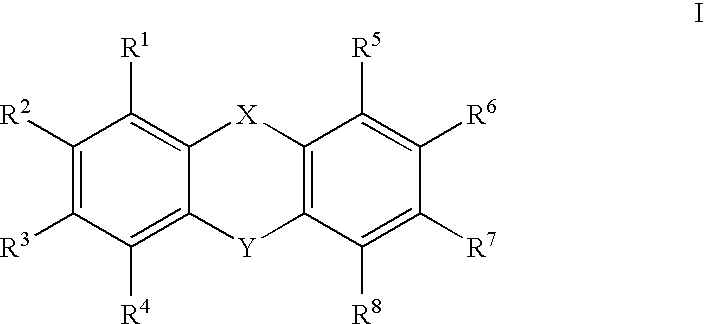Insecticidal tricyclic derivatives
a tricyclic derivative and insecticidal technology, applied in the field of insecticidal compounds, can solve the problems of cosmetic injury to crop plants, unappealing food products or ornamental plants, and loss of millions of dollars of value associated with a given crop
- Summary
- Abstract
- Description
- Claims
- Application Information
AI Technical Summary
Benefits of technology
Problems solved by technology
Method used
Image
Examples
example 1
[0140] This example illustrates one protocol for the preparation of 10-(1-methyl-4-piperidylidene)benzo[b,e]thiane (Compound 2 in table below) Under a nitrogen atmosphere, 45 mL of stirred THF was cooled in an ice-water bath. To this was added 8 mL (0.008 mole) of titanium(IV) chloride (1.0M solution in toluene) via a syringe, then 1.0 gram (0.016 mole) of zinc was added in two portions during a five-minute period. After this time the reaction mixture was stirred during a ten-minute period, then a solution of 0.76 gram (0.0036 mole) of thioxanthen-9-one and 0.56 gram (0.005 mole) of 1-methyl-4-piperidone in 20 mL of THF was added drop-wise during a ten-minute period. Upon completion of addition, the reaction mixture was stirred for ten minutes, then it was heated to 60° C. where it stirred for about 20 hours. After this time, the reaction mixture was cooled and poured into 50 mL of an aqueous 10% solution of potassium carbonate. The mixture was stirred for about 20 minutes, then 50 ...
example 2
[0141] This example illustrates one protocol for the preparation of 9-(1-methyl-4-piperidylidene)xanthene (Compound 8 in table below)
Step A Synthesis of 9-(1-phenylmethyl-4-piperidylidene)xanthene as an intermediate
[0142] This compound was prepared in a manner analogous to that set forth in Example 1, by the reaction of 0.78 gram (0.004 mole) of xanthone, 0.95 gram (0.005 mole) of 1-phenylmethyl-4-piperidone, 1.6 grams (0.024 mole) of zinc, and 12 mL (0.012 mole) of titanium(IV) chloride (1.0M solution in toluene) in 70 mL of THF. The yield of the subject compound was 1.4 grams. The NMR spectrum was consistent with the proposed structure.
Step B Synthesis of 9-[1-(2,2,2-trichloroethoxycarbonyl)-4-piperidylidene]xanthene as an intermediate
[0143] Under a nitrogen atmosphere, a solution of 0.7 gram (0.002 mole) of 9-(1-phenylmethyl-4-piperidylidene)xanthene in 50 mL of 1:2 chloroform: acetonitrile was stirred, and 0.85 gram (0.004 mole) of 2,2,2-trichloroethyl chloroformate was adde...
example 3
[0147] This example illustrates one protocol for the preparation of 2-(methylethyl)-11-(4-methylpiperazinyl)dibenzo[b,f]1,4-thiazepine (Compound 193 in table below)
Step A Synthesis of 2-[4-(methylethyl)phenylthio]benzenisocyanate as an intermediate
[0148] Under a nitrogen atmosphere a solution of 1.2 grams (0.0049 mole) of 2-[4-(methylethyl)phenylthio]phenylamine (known compound) in 60 mL of ethyl acetate was stirred, and 2.2 grams (0.011 mole) of trichloromethyl chlorooate was added by pipette in one portion. Upon completion of addition the reaction mixture was heated to reflux where it stirred for three hours. After this time the reaction mixture was cooled and concentrated under reduced pressure to a residue. The residue was further dried under vacuum, yielding 1.5 grams of the subject compound. The NMR spectrum was consistent with the proposed structure.
Step B Synthesis of 2-(methylethyl)-10-dibenzo[b,f]-1,4-thiazaperhydroepin-11-one as an intermediate
[0149] Under a nitrogen ...
PUM
| Property | Measurement | Unit |
|---|---|---|
| Fraction | aaaaa | aaaaa |
| Fraction | aaaaa | aaaaa |
| Fraction | aaaaa | aaaaa |
Abstract
Description
Claims
Application Information
 Login to View More
Login to View More - R&D
- Intellectual Property
- Life Sciences
- Materials
- Tech Scout
- Unparalleled Data Quality
- Higher Quality Content
- 60% Fewer Hallucinations
Browse by: Latest US Patents, China's latest patents, Technical Efficacy Thesaurus, Application Domain, Technology Topic, Popular Technical Reports.
© 2025 PatSnap. All rights reserved.Legal|Privacy policy|Modern Slavery Act Transparency Statement|Sitemap|About US| Contact US: help@patsnap.com



